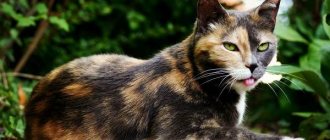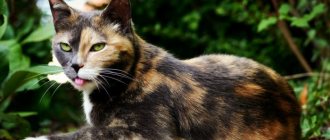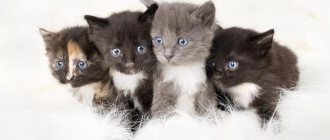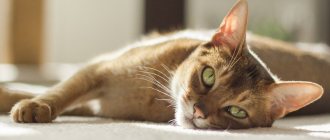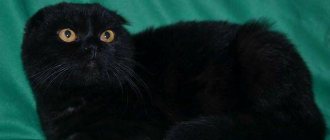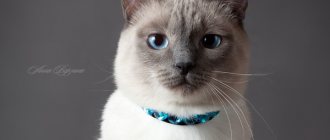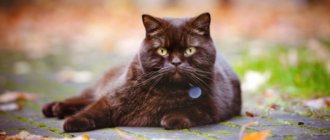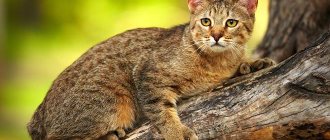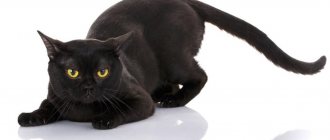Description and features
When nature dyes a cat's fur, it does things differently. Maybe the cat's hair is not dyed at all, then the cat becomes pure white. Can use two colors: black and orange. They are part of melanin, a chemical compound that colors wool. Mixing the black and orange components of melanin gives all the different colors of cats.
Black pigment often gives rise to its derivatives: brown, blue, purple, etc. Orange pigment can manifest itself as red, red, cream colors. Not only the colors are varied, but also their geometric implementation. A solid color is possible, it is called solid. Cat stripes and circles give a color called tabby. In this version, each hair is partially colored in one or another color.
A tortoiseshell color is often found - black and orange (red, red) spots of uncertain shape throughout the body. When tortoiseshell is placed on a white background, the resulting color combination is called calico. This name comes from the name of calico fabric, invented in India, the city of Calicut (now called Kozhikode).
Animals with this color are often called simply: tricolor cats. The color scheme is often called tricolor. The names don't end there. Often the tricolor color is called patchwork, calico, brindle. Spots of three colors fit into colors in which a white background predominates:
- harlequin - the white background should occupy 5/6 of the total area;
- van - spots in small quantities may be present on the head and tail, the rest of the animal is pure white.
In addition, the colored spots may have a pattern typical of a tabby. That is, the color is tricolor tabby. Owners consider tricolor cats to be especially affectionate, trusting, and playful. Positive character traits are noticeable not because of the colored spots on the cat’s fur, but because of the attitude of the owners towards the animals. All misdeeds of a creature that brings good luck and prosperity to the house will seem like a slight prank, a manifestation of playfulness.
Interesting information about cats with Calico color.
Calico cats (and tortoiseshell cats) are believed to be independent and not prone to sadness, which is why people have long taken them into their homes. If such a cat is adopted as a kitten, it becomes very attached to its owners. In the folklore of some cultures, Calico cats (and tortoiseshell cats) are believed to bring good luck. Japanese sailors often took Calico cats on their voyages, believing that the cat would protect them at sea. In the United States, Calico cats are often called "money" cats, in the belief that they attract money into the home. The Calico cat has been the official state symbol of Maryland since October 2001. Maneki Neko, a popular good luck figurine in Japan, is almost always sculpted to resemble a stylized Calico cat.
The tricolor color of cats, which helps to camouflage in their natural environment and consists of a combination of black, white and red tones, was called calico, by analogy with the brightly colored calico fabric that was imported to England from the Indian city of Calicut.
Calico cat is not a breed; they include long-, short-, and hairless beauties with appropriate pigmentation. For the majority, international standards have been established, and they are allowed to participate in exhibitions and competitions on an equal basis with representatives of the same color of their breeds.
Calico cat breeds
The patches of three colors on an animal's fur are not a characteristic of one or more breeds. special breed of calico cat . These can be any purebred or outbred cats. Considering the fame of cats with the Calico color, breeders are directing their efforts to consolidate this trait.
Unfortunately or fortunately, the appearance of a cat with spots of white, black and orange is a random event and not very common. Most breed standards allow the Calico color. This is first of all:
- shorthaired British and American cats;
- bobtails, Kuril and Japanese;
- Persian and Siberian cats;
- Manx;
- Maine Coon;
- masquerade cats;
- Turkish van;
- and others.
In all cases, it looks fresh and original. Especially in Persian, Siberian and other long-haired cats. In some cases, the edges of the spots are blurred, as if created with watercolor paint. Short-haired tricolor cats in the photo with this color look very elegant.
Genetics of Calico color.
In the case of the Calico color, the usual laws of genetics apply; the color of the kitten depends on the color of the parents. It is a widely known fact that the Calico color is found only in cats. This is due to the fact that the X chromosome is responsible for black and orange colors. A cat, like other mammals, has two such chromosomes, and cats have one X and one Y. Other genes are responsible for the white color. Thus, if a cat has one X chromosome that is black and the other is orange, the Calico color may appear. In a cat, with its only X chromosome, this is impossible. To be fair, it should be noted that there are cats with a combination of XXY chromosomes that can have the Calico color. However, animals with this genetic disorder are very rare, many die at an early age, and those that survive are sterile.
Signs
Everyone reacts the same way to a black cat that gets in the way of a person. It’s better to go back, go around the place where the cat ran, otherwise there will be no way. With a calico cat it's the other way around. If such an animal comes across to a person, expect good luck, you will soon be lucky, especially in matters related to money. The sign is old, tested, and works flawlessly.
When it comes to signs associated with cats, one of the first to come to mind is the belief that the cat should be the first to enter a new house and look around. She will bring peace to your home and deal with otherworldly forces.
If the cat is tricolor, then along with well-being, good luck and luck will settle in the house. A cat with a patchwork color living in the house is a source of luck. People did not limit themselves to a generalized statement.
The luck that a cat brings is detailed by color:
- orange spots are responsible for wealth,
- black spots are aimed at fighting dark otherworldly forces,
- white color governs kindness and purity of thoughts.
Signs of tricolor cats often take on specific forms:
- a patchwork cat protects the house in which it lives from fire;
- a Calico cat that came into the house by chance and strayed is a harbinger of an imminent wedding;
- a tricolor animal crossing the path of the wedding procession is a sure sign of a happy, large marriage;
- a calico cat with blue eyes had a special function - it protected family members from the evil eye, gossip and slander;
- a calico cat portends a person receiving good news, in the direction in which it is drawn;
- A wart rubbed with the tip of a Calico cat's tail should, according to knowledgeable people, soon disappear.
Japan is a country with a unique culture. Signs and beliefs associated with cats are not uncommon; they are certainly believed in even in our century. may not always live in the house But every Japanese wants to get their piece of luck from her. For this occasion, there is a porcelain figurine - a cat with a raised paw.
His name sounds like Maneki-neko. The color is mostly white, with black and orange spots. This money cat is found in offices, shops, apartments, ensuring the financial well-being of employees, visitors and residents. The Japanese act rationally: instead of an animal that requires care, they acquire its porcelain embodiment.
Tabby (tabby)
Such cats have stripes of an unusual shape and a different color than the main color. The most common marks are on the forehead, for example, in the shape of the letter M, light spots on the back of the ears, a necklace on the chest, rings on the paws and tail, curls on the cheeks, eyes outlined as if with shadows.
Breeders distinguish several variants of tabby. According to the type of pattern, they are marbled (shaded), tiger (mackerel) and spotted (spotted).
There is a complex classification of Scots tabby dogs based on combined colors and shades. They are presented in the table below:
| Name | Main color | Pattern color |
| Silver | Silver | Black |
| Silver blue | Light blue, white undercoat | Mantle on muzzle, tail and sides |
| Red | Light red | Bright red |
| Brown | Copper | Black |
| Blue | Cream blue | Bright blue |
| Cream | Pale cream | Beige or dark cream |
| Cameo | White | Bright red |
Only cats or cats can be tri-colored
If you come across a calico-colored animal on the way, with a 99.9% probability we can say that it is a cat, that is, a female. Calico cats are a rare phenomenon. The connection between color and the sex of the animal itself seems surprising. Scientists cannot yet explain why nature realized the opportunity to be painted in three colors for cats, but rejected it for cats.
Genetics explains this fact, but does not reveal the natural design. The cells of the male body are equipped with X and Y chromosomes, while female cells have two X chromosomes. It is the X chromosomes that determine which pigment will manifest itself in the color of the cat. The orange color comes from the pigment pheomelanin, the black color from eumelanin.
The X chromosome can only activate one pigment: either orange or black. The female has two X chromosomes, one can give rise to orange, the other - black pigment. Males have one X chromosome, which means the color of the spots can also be one: black or orange.
There are exceptions. Sometimes males are born with an XXY set of chromosomes (the so-called Klinefelter syndrome). Such males can become tricolored. Or have a two-tone, tortoiseshell color. Very few tricolor males are born. In addition, due to the presence of two X chromosomes, they do not produce offspring.
In everyday life, it is not necessary to remember the names of pigments, which chromosomes store the genes responsible for cat color. It is enough to know that only cats are full tricolor . Cats with the same color are flawed: there are very few of them, and they cannot give birth.
If a breeder plans to breed cats with patchwork colors, he will have to become more familiar with the basics of genetics and the peculiarities of the appearance of tricolor spots. After which the idea of breeding tri-colored short-haired or long-haired animals will come to naught. The good thing about tricolor cats is that it is impossible to predict their birth.
History of the tricolor color
Few facts have been preserved in history about the origin of this unusual color, mostly speculation and assumptions.
Most likely, this rare color arose and became established as a result of a spontaneous gene mutation.
Scientist Neil Todd, studying the migration of secondarily domesticated cats along the trade routes of Europe and North Africa, suggested that the homeland of such individuals is Ancient Egypt. It was from there that they came along with ships to the port cities of Italy and France and spread first throughout all European countries, and then throughout the world.
Biologists Murray Barr and Bertram began closely studying the tricolor or “tortoiseshell” color in 1948. They discovered that the female nerve cells contained rod-shaped black bodies called Barr bodies. This feature was not observed in males.
Ten years later, the Japanese geneticist Ono Susumu established that “Barr bodies” are nothing more than chromosomes of the female type - X. Marie Lyon, continuing his work, developed the concept of inactivation of this chromosome in females.
What to name a tricolor cat
When deciding what to name a tricolor cat , owners are guided by several motives:
- Associations caused by the color of a cat. In this section, the name Chubais is the leader among cats with large red spots.
- The first manifestations of character in a kitten. Often this is Sonya, Shustrik, Marsik (warlike kitten), Beda (in the sense of troublesome).
- Events or circumstances due to which the kitten appeared in the house. For example, Prize, Winter, Storm, Gift, Chief.
- Most often, a kitten is named spontaneously.
The names for tricolor cats differ little from the names of animals of other colors. The entire list of popular calico cat names looks impressive.
- Ava, Agata, Aya, Agnia, Aida, Anita, Anka, Ariadne, Ars, Artem, Astra;
- Barbie, Basya, Bella, Black, Lingonberry, Borya, Bob, Betty, Bertha, Bambi, Buka, Storm;
- Varna, Vanda, Varya, Vasilisa, Cornflower, Vasya, Venus, Viola, Willy, Vlasta, Vesta, Volya;
- Galya, Glafira, Glasha, Hera, Greta, Glafira, Gloria, Gerta, Golub;
- Dio, Gina, Julie, Deutsche, Dekabrina;
- Eva, Evdokinia, Elizabeth, Efim;
- Zhanna, Julia, Zhuzha, Georges;
- Zlata, Zimka, Zarya, Zarina, Beast;
- Ivanna, Isabella, Jonah, Isolde, Ipa, Isis, Irma, Iskra;
- Capa, Drop. Coco, Carolina, Clara, Constance, Cleo, Ksyunya;
- Lana, Lesya, Lina, Lu, Lulu, Lilu, Lina, Lily, Lilia;
- Mavra, Mara, Mars, Marusya, Maggi, Magda, Madeleine, Malvinka, Margot, Martha, Marfa, Matilda, Matryoshka, Mila, Milana, Milya, Mimi, Mia, Molly, Muse, Mura;
- Nana, Nata, Nessie, Nelly, Nefertiti, Ninel, Nina, Novella, Nora, Note, Nochka, Nate, Nyusha, Nyasha;
- Ori, Octava, Oktyabrina, Olympia, Osya;
- Pavlina, Panna, Paula, Panda, Praskovya, Panochka, Pans;
- Rada, Rimma, Rosa, Ruslan;
- Solomeya, Svoboda, North, Severina, Serafima, Sendy, Simon, Sophia, Susanna, Suzy, Susan, Styopa;
- Taiga, Tasha, Tosha, Trisha, Taira, Tess;
- Ulya, Ustya;
- Faina, Fanya, Fina, Fima, Fiona, Frau, Felicia, Flora;
- Eureka, Elsa, Emma, Eric;
- Julia, Juno, Utah, Yuna;
- Yarik, Yars.
High-breed kittens go to the owner's house with a name, which is formed according to special rules. The first letter is the same for all kittens of the same litter. The nickname must contain the name of the nursery or the name of the breeder. Some nurseries assign a word (toponym, surname, title, etc.) to themselves, which serves as an integral part of the nicknames of all kittens.
In the case of a kitten of high origin, the owner has to think about how to shorten the name to make it simpler and more memorable. The kitten quickly learns its name; it is advisable that it has no more than three syllables, then there will be no problems with memorization.
Color-point Persian cats, or Himalayan cats (color-point)
The Color Point Persian cat is a very special cat. In a word, the Siamese color and the Himalayan color are one and the same. Breeders in England, the USA and Europe spent a lot of effort to achieve perfection of the square silhouette, thick coat, mask and paws of the Siamese color. There were many problems with him. The Himalayan cat's nose should be snub-nosed, its ears tiny, its eyes very round and watery as little as possible. The color is indicated only on the face, tail, ears and paws. Against the background of long creamy elegant fur, a dark brown mask sets off clear blue eyes, but not too light.
In America in the 1990s, the Masked Persian is always called the Himalayan, but it is no different from the English or European color point. The CFA, GCCF and FIFe consider this cat to be a variety of the Persian, that is, a product of its evolution.
In one litter, kittens can be born both with an excellent contrast of body color and “points”, and with a darkened body. Litter-brothers (seal-point) Persians living in the same conditions and climate can have completely different colors: one will retain a light body color, the other will become almost black. The exhibition life of color points, compared to other colors, is short, although the standards allow “slight darkening of the body to match the points.” Regarding the complexity of judging, it should be mentioned that, for example, cream- and red-point cats “thrive” for a very long time, in particular, the points on the legs are formed by the year. Tortoise point cats (with tortoiseshell markings) are often uncolored red. Although according to the standard, at least one red spot on each point is quite enough. One of the most common shortcomings in colors is pale eye color.
Himalayan cats require careful grooming, especially before a show. It's not that they like being shaken from head to tail to fluff up their fur, but they generally don't resist. They should be brushed regularly to avoid tangles. It is permissible to pluck the hair on the tips of the ears (this is better than trimming them with scissors) to emphasize the tufts inside the ears and draw attention to the childish roundness of the muzzle.
Beautiful blue eyes water. For eye care, use a special lotion and a cotton handkerchief; cotton swabs are prohibited. The Persian cat causes a lot of trouble, so you need to think carefully before adopting such a kitten.
When choosing a show kitten, consult with a serious specialist; do not buy just anywhere. Color point kittens are born white, with colored spots appearing gradually on the tip of the nose and on the ears. The true color becomes visible at three months, as well as possible defects. In this case, you should again contact an experienced specialist. He alone can say whether our kitten will become just a beloved domestic cat (pet class) or an expensive exhibition exhibit (show class). A top-class cat is no more difficult to raise than any other, except for more careful care of the fur. She eats well, loves to play, run, jump, climb, and excitedly sharpen her claws on the scratching post that you should buy for her.
Black smoky Persian
Why do you dream about a tricolor cat?
The appearance of a calico cat in a dream is not always interpreted as the onset of happy, successful times. Much depends on the mise-en-scène. Unlike reality, the spotted creature that appeared in the kingdom of Morpheus does not make a person a priori lucky, but makes him think.
A dream in which a calico cat scratches near the door foreshadows for men a meeting with a woman who should please them. But this woman's intentions may not be entirely benign. The old established life order may change not for the better. For women, such a dream indicates an imminent clash with a rival.
After a dream in which a calico cat lies on a person’s body, it is a good idea to consult a doctor. Pay close attention to your health, listen to the organs on which the cat lies down.
There are dreams in which a cat with a calico color rubs at a person’s feet. In this case, it is impossible to avoid conflicts with someone close to you. If in a dream you were able to discern which color prevails in a cat’s fur, you can predict the nature of the disagreement. With the predominant color red (orange), the opponent will be cunning and two-faced. If black takes over, the opponent will be rude but straightforward.
Types of British tortoiseshells with white color
British tortoiseshell and white cats (bicolor, van, harlequin) come in the following types (consider colors with bicolor code - 03):
- black and red tortoise bicolor BRI f 03;
- chocolate-red tortoise bicolor BRI h 03;
- blue-cream tortoise bicolor BRI g 03;
- lilac-cream tortoiseshell bicolor BRI j 03;
- cinnamon-red turtle bicolor BRI q 03;
- fawn-cream tortoise bicolor BRI r 03.
Interesting Facts
On the main Japanese island of Honshu there is the Kii Peninsula. A railroad runs through it. The 14 km line connects the capital of Wakayama with the village of Kishigawa. Few people used the railway and it was decided to close it in 2007 as unprofitable.
A tricolor cat Tama lived at the station. After the line was closed, the cat automatically became homeless. Residents of other cities located along the railway began to visit Kishigawa just to look at the cat and have time to pet it for good luck. The cat brought good luck not only to passengers, but to the railway department - the flow of passengers increased. For this she was made an honorary station commander.
It turned out that besides the cat, there are many remarkable places in the area. Tourists and residents of neighboring regions have flocked to Wakayama Prefecture. The cat prevented the bankruptcy of the railway line and boosted the development of the tourism business. Over the past 7 years of work, the “honorary station master” tricolor Tama has brought 1.1 billion yen to the railway ticket office.
A fact indirectly related to calico cats, but very impressive. The online journal Nature reported in April 2021 that scientists from the University of California were able to read and voice human thoughts.
Sensors mounted on the head detected electromagnetic waves generated by the brain. The computer deciphered and reproduced the thought. The first mental phrase that received a sound embodiment was: “Get a calico cat, and the rodents will go away.”
In Krasnoyarsk there is a children's technology park "Tvori-Gora". One of the activities of which is educational work. That is, there are a lot of visitors. All of them are met and accompanied by the tricolor cat Florida. This was reported in March 2021 by the online publication “City News” from Krasnoyarsk. The cat is included in the staff and receives a salary with food and affection.
Famous Calico cats
The popularity of tricolor beauties is reflected in the use of their image. Since October 2001, the calico has become the official symbol of the state of Maryland (USA). The Maneki-neko figurines common in Japan, which bring good luck, always depict a tri-colored cat.
And the Japanese mike (three-flowered) Tama saved the Kishi railway station, which was on the verge of ruin, from closure, received the title of samurai and became in 2007 “an honorary eternal station keeper.” The interest of tourists in the cat, which always greets passengers, turned out to be so great that this made it possible to solve the problem of financing.
Character and temperament
Persians have a soft, calm and flexible disposition. Representatives of the breed are completely devoid of aggression and rarely express dissatisfaction. The affectionate nature of Persian cats extends to all family members. However, most often they choose one owner and try to follow him everywhere.
Loving Persians need constant attention and do not tolerate long separations from their owners.
Breed and children
Persian cats easily make contact with children of different ages and will never harm children. The main thing is that children know how to properly communicate with a pet and not offend it.
Breed and other animals
Non-conflict and friendly Persians get along well with dogs, cats and even decorative birds. At first they may be cautious, but after getting to know each other better they will become more friendly.
Care and maintenance
The Persian cat is an elite breed. Keeping such an animal will require a lot of attention and considerable financial expenses from the owner. You are unlikely to find any other cat that would be as dependent on a person as the Persian. In order for your pet to always be beautiful and healthy, you will have to provide him with proper care, balanced feeding and proper support from an experienced veterinarian.
As for the living space, everything is more or less clear here. Persian cats are very calm and pliable; they like to spend a lot of time either in the arms of their owner or in a cozy, comfortable place allotted to them. They will easily get used to both the conditions of a city apartment and a large country house. The main thing is that family members do not forget about the animal.
Owners of private houses do not have to worry about their cat getting lost when going out for a walk. Persian cats are exceptional homebodies, and walking outdoors is not one of their favorite activities.
These cats are not hunters at all. Due to their phlegmatic nature, they get along well with other pets, including birds and rodents.
The Persian cat really values comfort and coziness. If opportunities allow, purchase a special sleeping place for your pet - a house or a bed. Your concern will definitely be appreciated. A soft chair or sofa will be a completely acceptable alternative for the animal. In this case, you should exercise caution and attentiveness, especially with a kitten. You can inadvertently injure your baby if he sleeps in your bed or likes to lie in the chair in which you are used to reading newspapers or watching TV.
Clipped Persian cat
Persian cats are very impressionable creatures. Never force your pet out of its home. If the cat is resting, do not touch it. Wait until your beauty wants to go outside on her own; in extreme cases, lure her with her favorite treat or interest her with a toy.
If your cat's house is not equipped with a scratching post, make sure to purchase one additionally. Ask the breeder what type of accessory the kitten is familiar with and buy a similar product. To train your little Persian to sharpen his claws in one place, use catnip. If you notice your animal's desire to get a manicure, immediately take it to a certain place. Persian cats are very intelligent creatures and will quickly figure out what you want to achieve from them.
Like any cat, a representative of the breed is very clean and will definitely try to bury the products of its vital activity. Persians can dig around in the litter box for a very long time before going to the toilet. To avoid being irritated by the filler scattered around, purchase a large tray with a high side (at least 10 cm). Prefer granular filler with high absorption capacity over wood filler. Immediately buy a tray designed for an adult animal. It will be convenient for the kitten to do his business in it, and when he grows up, he won’t have to spend money on a new one. The toilet can be placed on a larger rubberized mat. This will make cleaning up after your pet much easier.
An important accessory is a special carrying bag. You will need it for a visit to the veterinarian, for a trip to an exhibition, and when moving from a city apartment to a country house. The accessory must be suitable in size for the pet so that the animal feels comfortable enough inside.
White Persian cat
Thanks to its thick, long hair, the Persian cat tolerates the cold well, but it is still worth taking some preventative measures to avoid colds. Do not place the cat house or bed near entrance doors, windows or other places where drafts are possible. And if your pet prefers to spend time lying on the windowsill, lay a soft, warm cloth for him.
Just try to take my chicken
In matters of nutrition, almost all breeders without exception recommend choosing ready-made food of the highest quality category. Precisely calculated and well-balanced daily intakes will provide your cat with everything it needs, even without adding natural products to the diet. Mixed or natural feeding is more troublesome, since sometimes there is not enough time to prepare food for the cat separately, and the human menu is not suitable for it by definition. Seasonings, sugar, and salt in excess quantities can cause serious harm to the cat's body. Be sure to introduce special vitamin supplements with a seaweed complex into your cat’s diet in the required proportions (1 tablet with calcium + 3 tablets with algae extract or vice versa - depending on color) (for any type of feeding). The availability of freely available clean water is not even discussed.
Persian cats are prone to overeating, so you need to control their diet and under no circumstances feed them from your table or from your hands.
The special pride of the Persian cat is its fur. Caring for her is an art. You will need various tools - a rare comb with rounded teeth, a natural bristle brush, regular hair cutting scissors. During seasonal shedding, a special spray for removing fur may be useful.
Milaha
The structure of the animals' fur is such that without systematic care, tangles form very quickly, which can only be gotten rid of in a radical way. To avoid such troubles, some owners comb the animal daily and rarely bathe it, while others, on the contrary, often use water procedures followed by styling the fur. You can choose your path only through experimentation. The main thing is systematicity and constant adherence to the chosen procedure.
For the purpose of prevention, it is recommended to sprinkle the fur with a special grooming powder purchased at a pet store. Baby powders are not suitable: they contain starch, which is harmful to the cat’s body, and the cat will definitely swallow it while licking itself.
Do not use a slicker when caring for the hair of a Persian cat - the undercoat hairs of this breed are restored very slowly. Do not comb your pet's tail unless absolutely necessary.
Caring for the Persian cat's ears and teeth is standard, but the animal's eyes require a little more attention. They need to be cleaned daily, but not with cotton wool, but with a clean soft cloth moistened with special drops or distilled water. Do not use any wet wipes!
The animal should be bathed in warm water (depth no more than 10-12 cm) using special shampoos, avoiding getting the head wet. As a precaution, apply special drops to the Persian cat's eyes and place cotton swabs in the ears.
Considering the natural laziness of Persian cats, it is necessary to play with them to keep fit: with kids - 3-4 times, with adults - 1-2 times a day.
Health and susceptibility to disease
Persian cats are gentle and fragile creatures that live on average 13-15 years. Due to the special structure of the muzzle, representatives of the breed are predisposed to breathing problems and may snore in their sleep.
For more information about how long Persians live, read the article “Life expectancy of Persian cats.”
Persians also have a tendency to:
- to hypertrophic cardiomyopathy;
- polycystic kidney disease;
- idiopathic dermatitis;
- eye infections;
- gingivitis.
Smoky Persian cats (smoke)
Smoky Persian cats have coat colors ranging from black on the head, legs and back of the body to silver on the collar, sides and ear tufts. The ash-colored undercoat is a pleasing contrast to the black topcoat. It is noticeable when the cat is brushed against the grain or at favorable times - between periods of shedding. These animals are also called “cats of contrasts” - they have silvery shades of indescribable beauty.
In a calm state, a smoky animal is no different from an animal of even color - black, cream, tortoiseshell and blue. But as soon as the pussy shakes its wonderful fur coat, the color immediately changes and becomes a match for the precious fur of a black-brown fox. This beautiful silver-white undercoat is the main asset of the smoky color. The guard hair of smoky animals is also not monochromatic: at the base, by approximately one third, the main color is lightened almost to white. This is caused by the action of the melanin inhibitor gene, which is inherited dominantly. It is quite difficult to grow truly beautiful “smoke” - only fanatical felinologists are capable of this.
The main value of a smoky animal is its silvery undercoat, and it must be combed carefully, trying not to damage it , using special metal combs with wide teeth, using special antistatic agents that make combing easier and prevent the formation of tangles. And if they do form, they need to be carefully sorted out with your fingers and not combed out, otherwise a darker spot will form on the bare area, which is a serious drawback. A smoky animal should be washed twice a week from the age of one and a half to four months, then once a week.
When preparing a smoky Persian for an exhibition, you cannot use lightening powders and shampoos. Before washing with shampoo, the wool should be degreased with Crystal Shine dishwashing liquid with lemon or Bingo. After washing with shampoo, rinse with a solution of vinegar in a ratio of one to forty and rinse again. When wet, do not comb the fur. Dry under a powerful hairdryer, lifting the hair by the ends using a slicker. It is advisable not to touch the prepared animal with your hands, but before the ring you need to comb, shake and smooth the fur.
When mating two smoky animals, magnificent colors are obtained, and the type is improved through selective selection. This path is longer and more difficult, but it gives more stable, genetically fixed results. When breeding smokes, it is recommended to mix black and tortoise smoke with red and cream smokes. And weakened colors are intense. The most successful for breeding clarified smokes are combinations of clarified colors with heterozygous intense carriers in the Dd clarifier gene genotype.
Persian silver chinchilla
